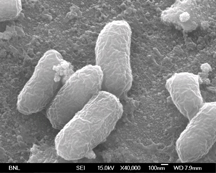Endophytic bacteria are bacteria that reside within the living tissue of the plant without substantively harming it. They are ubiquitous in most plant species, residing latently or actively colonizing the tissues. The diversity of the bacterial endophytes is exhibited not only in the variety of plant species colonized, but also in the many taxa involved, with most being members of common soil bacterial genera such as Pseudomonas , Burkholderia , Bacillus , Enterobacter and Azospirillum (for review, see Lodewyckx et al . 2002). Endophytic bacteria have several mechanisms by which they can promote plant growth and health. These mechanisms are of direct importance to the DOE mission of carbon sequestration through biomass production. In addition, endophytic bacteria can help their host plants to overcome the phytotoxic effects caused by environmental contamination, which is of direct relevance for waste management and pollution control via phytoremediation technologies (Barac et al , 2004). Enterobacter sp. 638 was isolated in association with Populus trichocarpa x deltoides and represented a commonly found endophytic bacterium associated with poplar. Sequence analysis shows that this strain is closely related to the plant growth promoting bacteria Pantoea sp. and Buttiauxella sp. Recently it was shown that bacteria belonging to the order Enterobacteriales can affect nodule formation by legumes (Benhizia et al , 2004). In addition, these plant growth promoting bacteria can fix nitrogen, produce plant hormones and have a complex pathway of signaling which is controlled by N-acylhomoserine lactone signal molecules (Veselova et al , 2003)). The family Enterobacteriacae includes free-living, commensal and pathogenic bacteria associated with host species ranging from plants to humans. Complete genome sequences provide an opportunity to dissect the genetic basis of phenotypic differences and study the evolutionary dynamics of this group. Enterobacteriacae genomes that are being sequenced to date are that of the pathogens Enterobacter sakazakii (at Washington University School of Medicine), Escherichia coli strains, Shigella flexneri , and Yersinia pestis (University of Wisconsin, Madison, Genome Evolution Laboratory), all of which are animal associated enterobacteria, the Pantoea citrea genome (at Genencor), the genomes of the plant associated enterobacteria Erwinia chrysanthemi , Erwinia amylovora and Pantoea stewartii (University of Wisconsin, Madison, Genome Evolution Laboratory) and the genome of Erwinia carotovora subsp. atroseptica . The genome of the last was used to study and characterization the virulence factors of this enterobacterial phytopathogen (Bell et al , 2004). Sequencing of the Enterobacter sp. R558-1 genome (and also that of Enterobacter sp. 638) and comparative genomics with other, non-endophytic and pathogenic Enterobacteriacae should provide us with a better understanding about the critical functions controlling the symbiotic relation ship between these endophytes and their poplar host. References Barac, T., S. Taghavi, B. Borremans, A. Provoost, L. Oeyen, J. V. Colpaert, J. Vangronsveld, and D. van der Lelie. (2004). Engineered endophytic bacteria improve phytoremediation of water-soluble, volatile, organic pollutants. Nature Biotechnol. 22(5): 583-588. Bell, K. S., M. Sebaihia, L. Pritchard, M. T. G. Holden, L. J. Hyman, M. C. Holeva, N. R. Thomson, S. D. Bentley, L. J. C. Churcher, K. Mungall, R. Atkin, N. Bason, K. Brooks, T. Chillingworth, K. Clark, J. Doggett, A. Fraser, Z. Hance, H. Hauser, K. Jagels, S. Moule, H. Norbertczak, D. Ormond, C. Price, M. A. Quail, M. Sanders, D. Walker, S. Whitehead, G. P. C. Salmond, P. R. J. Birch, J. Parkhill, and I. K. Toth. (2004). Genome sequence of the enterobacterial phytopathogen Erwinia carotovora subsp. atroseptica and characterization of virulence factors. PNAS USA 110: 11105-11110. Benhizia, Y ., H. Benhizia , A. Benguedouar , R. Muresu , A. Giacomini , and A. Squartini . (2004). Gamma proteobacteria can nodulate legumes of the genus Hedysarum. Syst. Appl. Microbiol. 27: 462-468. Lodewyckx, C., J. Vangronsveld, F. Porteous, E. R. B. Moore, S. Taghavi, M. Mergeay, and D. van der Lelie (2002). Endophytic bacteria and their potential applications. Crit. Rev. Plant Sci. 21: 583-606. Veselova, M ., M. Kholmeckaya , S. Klein , E. Voronina , V. Lipasova , A. Metlitskaya , A. Mayatskaya , E. Lobanok , I. Khmel , and L. Chernin . (2003). Production of N-acylhomoserine lactone signal molecules by gram-negative soil-borne and plant-associated bacteria. Folia Microbiol (Praha) 48: 794-798. |
||
|
||
Enterobacter sp. 638

 Image provided by Dr. Barbara Panessa Warren.
Image provided by Dr. Barbara Panessa Warren.